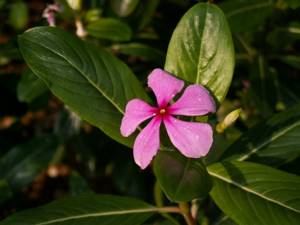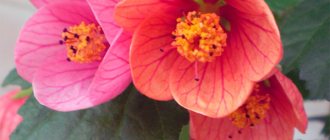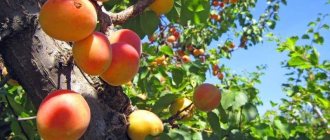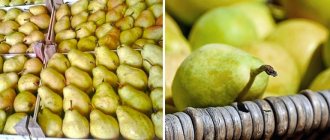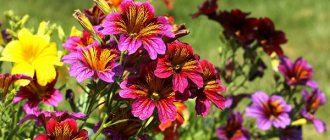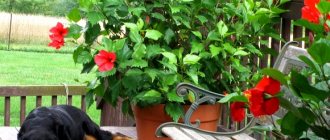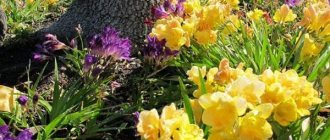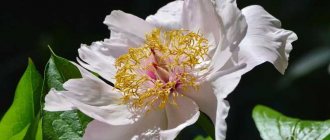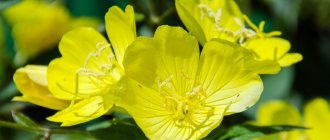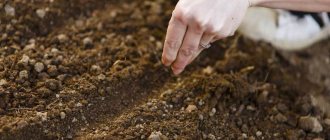Description and varieties
An evergreen perennial plant, periwinkle spreads along the ground, covering it with a beautiful carpet. The leaves of the plant are dense and endowed with an original shine. The inflorescences have a purple or blue tint. The five-petalled flowers are solitary and located in the leaf axils.
The funnel-shaped corolla has a cylindrical tube. The fruit is a leaflet. The external attractiveness of the flower can be seen in the photo of periwinkle. Having a powerful root system, it covers the area and does not allow weeds to develop.
Several types of flowers grow under natural conditions, but experts have managed to develop a number of varieties that differ in color diversity. The most well-known types are:

Large periwinkle - distinguished by larger leaves and flowers, reaching 25 cm in height. It can bloom up to twice a year.
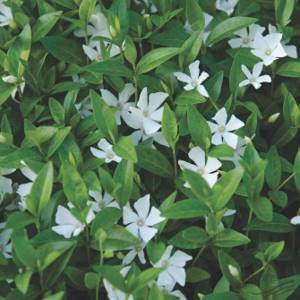
Herbaceous periwinkle - characterized by low frost resistance and small ovoid leaves with a rich green tint.
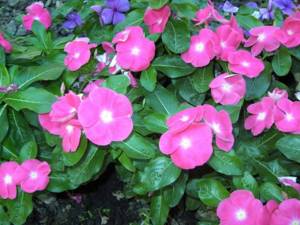
Periwinkle pubescent is a frost-resistant species with small flowers that sheds its leaves in winter.
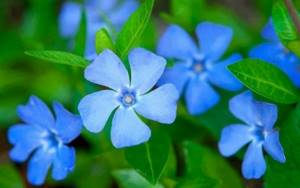
Lesser periwinkle is a plant with elliptical leaves and creeping stems reaching 1 m in length. It has small blue inflorescences and is frost-resistant.
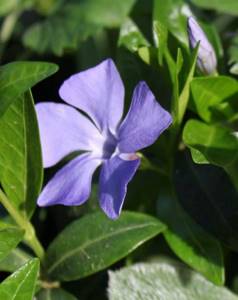
Description of the plant
Periwinkle is a perennial plant; it can be either deciduous or evergreen. The genus is represented by subshrubs and herbaceous plants. Belongs to the Kutrov family. It consists of 12 species, only 4 are cultivated in temperate climates. One of the species of periwinkle, Catharanthus, was bred by scientists into a separate genus.
Wild specimens can be found in North Africa and the Eurasian continent
Periwinkle is called differently:
- Official botanical name: Vinca
- Common names: brilliant green, burial ground, coffin-grass, devil's eye, joy of the earth, sorcerer's violet, gentian and others
Its leaves are leathery and colored in various shades of green. They may have inclusions of a lighter tone or a border around the edge. They are located opposite.
The peduncle has one flower each. The color is most often blue, but pink and lilac flowers are also found. They consist of 5 petals.
Abundant flowering occurs in early spring. No wonder it is considered a harbinger of spring. Periwinkle has a big advantage: its single flowers continue to bloom until autumn. The fruit ripens as a pair of leaflets.
Medicinal properties of periwinkle
Periwinkle is an extremely useful plant, which is why it has long been used both in pharmacology and medicine. The fact is that this plant contains an alkaloid that can prevent cell division. Today, the industrial cultivation of such a crop has been discontinued, since they have learned to synthesize this alkaloid artificially. It is part of immunosuppressants and antitumor agents. However, despite this, periwinkle is medicinal and today is widely used in the treatment of various cardiovascular diseases:
- Vinca pubescent contains glycosides called pubescin and vinine, which help lower blood pressure.
- Pink periwinkle contains the alkaloid reserpine, which is quite valuable. It also helps lower blood pressure.
- Vinca herbacea contains rutin, which is what doctors often prescribe for hypertension.
Lesser periwinkle also contains glycosides. In addition, some types contain ursolic acid and other active substances.
In addition to alkaloids, periwinkle contains tannins, anthocyanins, organic acids, sugars, vitamins, mineral salts, steroids and phenolic compounds. Products made from this plant are used in the treatment of diseases such as: cerebrovascular accident, osteochondrosis, ischemia, atherosclerosis, vascular damage, psychosis, schizophrenia, depression, autonomic neurosis, polyneuritis, motor coordination disorder, consequences of meningoencephalitis, and also complex diseases of the ears, throat, nose - sensorineural hearing loss, ototoxic neuritis, vasomotor rhinitis, decreased sense of smell, post-influenza neuritis of the auditory nerve, atrophic rhino-pharyngolaryngitis.
In alternative medicine, this plant began to be used back in the times of Dioscorides and Pliny the Elder. For example, catharanthus in China was used to treat hypertension. In the Caucasus, the species of periwinkle growing there are distinguished by their antimicrobial, vasodilating, blood purifying, strengthening, wound healing and hemostatic effect. This plant was used to treat colic, toothache or headache, sexual weakness, diabetes mellitus, female diseases, scurvy, bad breath, fever, tuberculosis, colds, etc. It was also used externally for bleeding of the uterus or from the nose, for lotions for itching, rashes and skin eczema, as well as wounds.
Periwinkle Medicinal properties Watch this video on YouTube
Contraindications
Periwinkle is considered a poisonous plant, so it is forbidden to treat it yourself. Before you start taking medications from this plant, you should consult a specialist. The fact is that in case of overdose there is a depression of cardiac activity. The use of such products is prohibited for pregnant women, at any time.
Features of planting
Periwinkle is an unpretentious plant. It takes root well both on flat surfaces and on hills and slopes. It also does not depend much on the sun - it can grow in the shade of trees and under bright sunlight, although the first option would be more preferable for it.
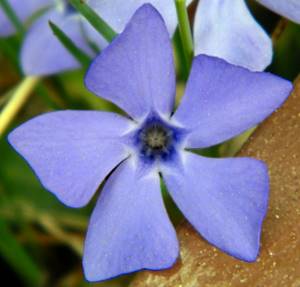
It is advisable to plant it in loose, fertile soil. Feels great on neutral soils with good drainage. That is why it can often be seen in the tree trunks of fruit trees.
The flower is a perennial, characterized by active growth, so planting periwinkle in open ground should be done with intervals of 30-35 cm between individual plants.
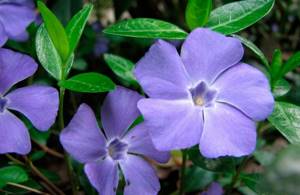
Summarizing
The following conclusions can be drawn. Periwinkle, which grows in Russia, is an unpretentious plant with beautiful smooth, sharp leaves and bluish flowers. Can be grown under artificial conditions. Resistant to most pests, looks beautiful in flower beds and front gardens.
It blooms for about 30 days. Planted mainly in spring and summer. Currently, about 6 main varieties are known. In addition, periwinkle is a flower that is actively used in traditional and folk medicine. Contains beneficial alkaloids. Some species have pronounced antitumor properties. Thanks to this, many drugs have been discovered that are still used today.
Periwinkle is not only a beautiful and interesting plant, but also has many beneficial properties both when taken internally and simply for visual contemplation.
Plant care
Periwinkle is very unpretentious and does not require special attention. At the time of planting in the ground and during the process of active growth, additional watering is carried out.
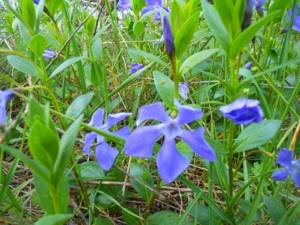
The rest of the time, the moisture that is contained in the soil, entering there naturally, is enough for him. It is drought-resistant, so even in the hottest periods it is not recommended to water more than once every 8-10 days.
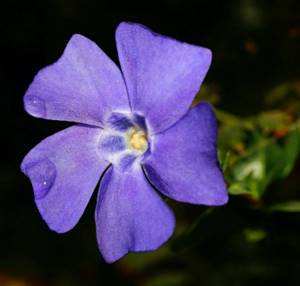
Most species tolerate winter well. However, it is still recommended to cover young shoots. Dry leaves are used for this.

There are no strict requirements for feeding periwinkle. However, the plant responds positively to balanced organic or mineral fertilizers. It is recommended to apply 30-40 g of urea per 1 square meter. m flower beds.
Fertilizing with humus and peat compost is also useful. Organic matter is added twice during the flowering period - in spring and in the last week of September. Dying own leaves will also be an excellent fertilizer.
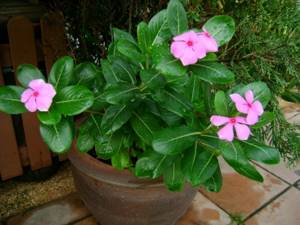
The periwinkle will deal with weeds on its own, so you don’t have to pay any attention to the fight against harmful vegetation. To improve tillering, periodic pinching of shoots is advisable. Moreover, this must be done for both young and older sprouts. When flowering has finished, prune. Cut cuttings are suitable for creating new plantings.
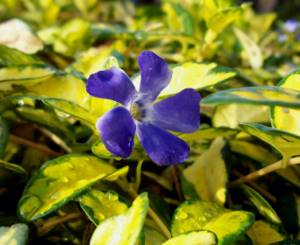
Periwinkle - planting and care photo
This plant is rightfully considered a ground cover, because its creeping stems quickly take root and produce new branches. It is also one of the most unpretentious crops that can survive in the shade.
Having planted periwinkle once, you don’t have to worry about its further development. The bushes themselves will multiply and spread throughout the area, and can even crowd out neighboring, less tenacious plants.
When and how to plant
Periwinkle reproduces both by seeds and vegetatively. Seeds are usually sown directly into the ground in April, but you can first plant them for seedlings in March.
However, vegetative propagation is most often used:
- planting sections of bushes;
- rooted shoots;
- cuttings of shoots.
These methods give faster results and allow you to see flowering already in the year of planting.
Periwinkle feels best in a semi-shaded location, with the exception of the herbaceous variety. Even if there is a lack of light, it will grow, but flowering will not occur. The flower prefers loose, nutritious soil with neutral acidity. Before planting, it is advisable to dig up the flower bed and add compost.
How to care
Caring for periwinkle will be minimal, because this culture is distinguished by its vitality. Basically, you should visit young plantings more often to help them get stronger. To do this, you need to monitor and water the bushes on time, you can feed them with organic matter. In the future, adult bushes can develop without the help of a gardener. If it rains, that's enough for them.
Periwinkle is not particularly demanding when it comes to fertilizing. It is enough to apply fertilizers only twice per season: in the spring - compost, in the fall - potassium-phosphorus preparations.
The bushes overwinter well without additional shelter. Only the large periwinkle in the middle zone needs good mulch. It has the lowest winter hardiness and after freezing the bushes are difficult to recover.
Features of reproduction
Periwinkle can be propagated by cuttings, cuttings, seeds and dividing the bush. The last option is considered the simplest. It is enough to separate part of the plant and plant it in a separate place.
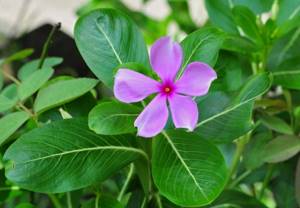
The plant will quickly take root and begin to grow. Planting is done in the spring or in the first weeks of autumn. If you decide to carry out the operation in the summer, then the soil under the flower and in the new place must be moistened.
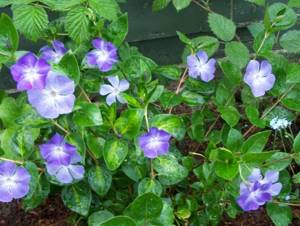
You can also plant cuttings. To do this, young shoots are cut and planted in the ground at a distance of 30 cm from each other. The cutting is sprinkled with earth so that a few leaves remain on the surface.
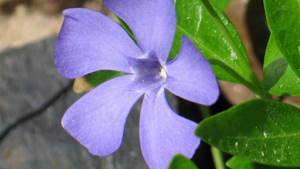
For evergreen species, the diversion method is excellent. To do this, the stem is dug into the ground, and after rooting, the sprout can be separated from the mother bush and, if necessary, planted in another place.
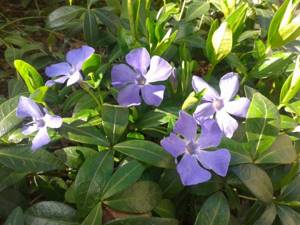
But the seeds of this perennial need to be planted in boxes, for which small holes up to 2 cm are dug. This is done in the spring. After this, the container is covered with thick cloth or film. The room temperature required for seedling development is more than 22-23 degrees.
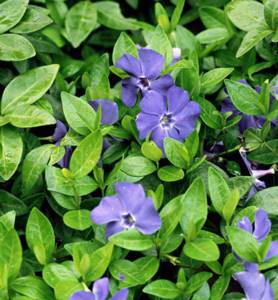
After the first shoots appear, the shelter can be removed and the box itself can be exposed to light at an air temperature of 20 degrees. As soon as the first 3-4 leaves appear at a height of 8-9 cm, the seedlings can begin to be planted.
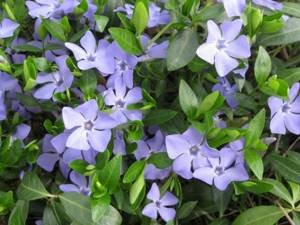
The periwinkle flower is best propagated in the spring. This will allow the plant to take root before winter and become stronger before the cold weather begins.
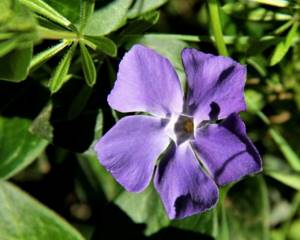
Planting periwinkle in open ground
As already written above, the plant should be planted in the fall, even before the onset of frost, or in early spring. The amount of watering will depend on the chosen location. Let's take a closer look at when to plant periwinkle, and what recommendations need to be followed so that the culture takes root and pleases the eye with its beauty.
Features when landing:
- The landscape must have fertile soil.
- It is better to plant the crop in places where there are low trees that will create partial shade during the day.
- Dig up the selected area and level it with a rake.
- Plant in a checkerboard pattern, taking into account that the size of the holes must correspond to the size of the root system of the cuttings or seeds.
- Fill the holes with earth and compact them. Water generously.
Note! Planting plants in a checkerboard pattern will not only allow you to get a densely planted flower bed, but also prevent soil erosion
Disease and pest control
If periwinkle is highly resistant to most diseases, then pests can attack it. This applies to aphids, scale insects, powdery mildew and other fungal diseases.

Spraying with a soap solution helps fight aphids and scale insects, and in order to prevent powdery mildew, you must carefully monitor the watering procedure.
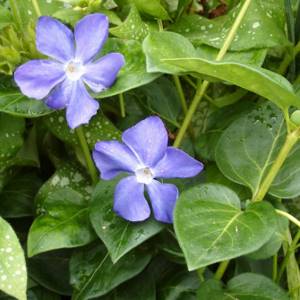
It is not recommended to over-moisten the soil. Special solutions such as Topsin, Skor or Topaz will help get rid of powdery mildew that has already manifested itself. Cuproxate and Bordeaux mixture are effective in fighting rust.
Decorative design
Periwinkle can be a wonderful garden carpet. It combines with lungwort, primrose, scillas, as well as hyacinths and forget-me-nots. The plant is also used in the design of flower beds, borders, and ridges. It is perfect for decoration and at the same time strengthening slopes and slides.
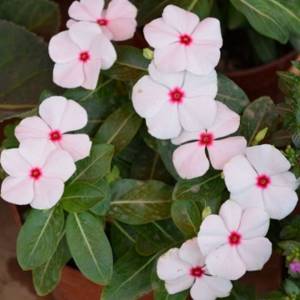
Often used as an hanging plant - periwinkle hanging from the walls of retaining walls looks great against the background of stone. Thanks to its bright colors, the perennial serves to create accents in the flowerbed.
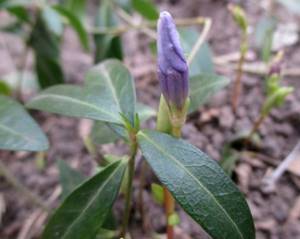
Use in medicine
The alkaloid contained in the plant is used in pharmacology in the manufacture of antitumor drugs. It is also known to have properties as a component for immunosuppressants. Due to the presence of glycosides, periwinkle is used in the fight against cardiovascular diseases.
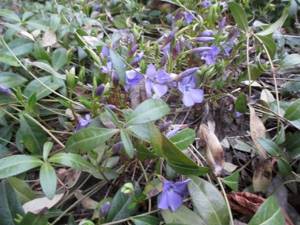
The pubescent periwinkle helps lower blood pressure, the herbaceous one is useful for hypertension, and the small one has a positive effect on the functioning of the heart. The flower contains tanning components, acids, as well as vitamins and sugar.
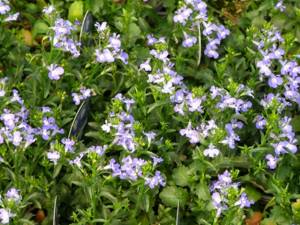
Preparations made from it are used to treat osteochondrosis, ischemic disorders, atherosclerosis, nervous disorders, depressive conditions, and ENT diseases. Some species have antimicrobial and wound-healing effects.
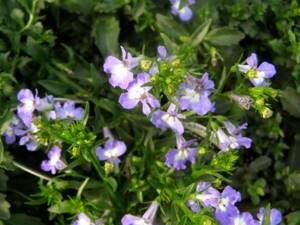
Periwinkle has not only decorative and aesthetic, but also medicinal value. It does not require much care and is easy to reproduce and grow. This plant is perfect for gardens and garden plots.
